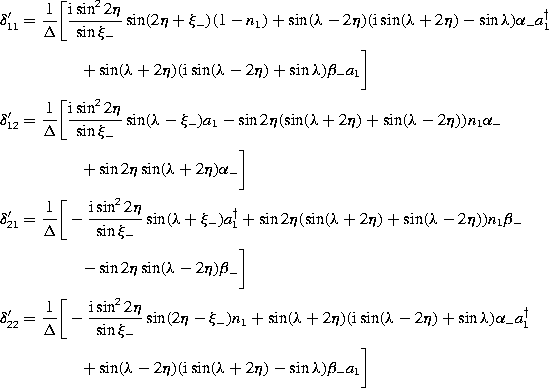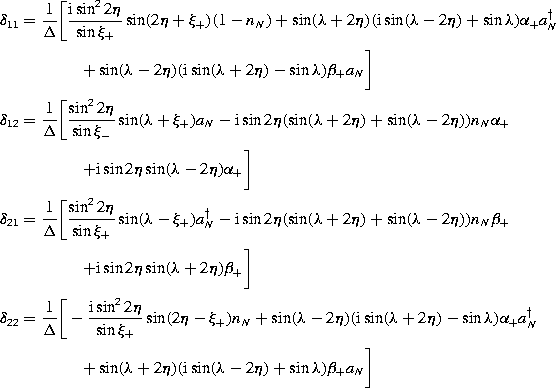CCAST (World Laboratory), PO Box 8730, Beijing 100080, People's Republic of China, and
Department of Physics, Chongqing University Chongqing, Sichuan 630044,
People's Republic of China![]()
Received 21 Sept. 1998
Abstract:
The Lax pair for the one-dimensional small-polaron open chain is explicitly constructed. From this the general boundary K-supermatrices are found. Our construction provides a direct demonstration for the integrability of the system.
In the last decade, much attention has been paid to the study of completely
integrable lattice spin open chains [1] - [8].
As was shown by Sklynanin [1], there is a variant of the
usual formalism of the quantum inverse scattering method (QISM) [9]
- [11], which may be used to describe systems on a finite
interval with independent boundary conditions on each end. Central to his
approach is the introduction of an algebraic structure called the reflection
equations (RE) [12]. Although Sklyanin's argument was
carried out only for the P and T invariant R-matrices,
it is now known that the formalism may be extended to apply to any systems
integrable by the quantum R-matrix approach [8].
Much attention has been paid to the solutions of RE which present the boundary
K-matrices
compatible with the integrability. Recently, the boundary
K-matrices
have been constructed by several groups [6] for the Heisenberg
spin-![]() open chain and by the present author [7,8]
for the one-dimensional (1D) Hubbard open chain and for the 1D Bariev open
chain.
open chain and by the present author [7,8]
for the one-dimensional (1D) Hubbard open chain and for the 1D Bariev open
chain.
On the other hand, the traditional basis for applying QSIM to a completely integrable system is to represent the equations of motion of the system into Lax form. Following Korepin et al [9,10], one may show that, for systems with periodic boundary conditions, the existence of the quantum R-matrix allows one to express the original equations of motion in Lax form. In particular, the Lax pairs for a variety of physically interesting models were given in [13] - [16]. Thus, one may expect that there is a variant of the usual Lax pair formulation to describe quantum integrable lattice open chains. Recently, we have shown that such a formulation does exist [17].
The aim of this letter is to present the Lax pair for the 1D small-polaron open chain in explicit form. From this the general boundary K-supermatrices are determined. Our construction provides a direct description for the quantum integrability of the system.
Let us first recall the Lax pair formulation for completely integrable lattice fermion open chains described in [17]. Instead of directly considering the equations of motion, let us study an operator version of an auxiliary linear problem:

Here ![]() ,
,![]() ,
, ![]() and
and ![]() are some supermatrices depending on the spectral parameter
are some supermatrices depending on the spectral parameter ![]() and the dynamical variables. The consistency conditions for equation (1)
yield the Lax equations
and the dynamical variables. The consistency conditions for equation (1)
yield the Lax equations

A lattice fermion open chain is said to be completely integrable if we can express the equations of motion in the Lax form (2), provided the boundary K-supermatrices exist as the solutions of equations (4) and (5) below. In fact, it is readily shown that a transfer matrix
![]()
does not depend on time t, provided the constrains hold:
![]()
and
![]()
with
![]()
Here the supertrace `str' is taken over the auxiliary superspace. This implies that the system under study possesses an infinite number of conserved quantities.
Now, let us study the 1D small-polaron open chain with Hamiltonian

Here ![]() and
and ![]() are, respectively, the creation and annihilation operators at lattice site
j, and satisfy the usual anti-commutation relations
are, respectively, the creation and annihilation operators at lattice site
j, and satisfy the usual anti-commutation relations
![]()
and ![]() is the density operator,
is the density operator, ![]() .
Furthermore,
.
Furthermore,![]() is a coupling parameter and
is a coupling parameter and ![]() ,
, ![]() and
and![]() are some members of Grassmann algebra with
are some members of Grassmann algebra with ![]() even and
even and ![]() odd, satisfying
odd, satisfying ![]() .
.
It is not difficult to check that the equations of motion derived from the Hamiltonian (7) may be cast into the Lax form (2). Indeed, in our case, the L and M matrices take the form [16]

and

with

Here we emphasize that the L and M matrices are
supermatrices with parities ![]() ,
, ![]() .
From equation (2), it follows that
.
From equation (2), it follows that
![]()
with

and
![]()
with

where ![]() .
.
We now proceed to study the constraint conditions (4) and (5). Let us
assume the boundary K-supermatrix ![]() to take the form
to take the form
![]()
and, substituting into equation (4), one may check that, out of
the 16 homogeneous linear equations about ![]() ,
, ![]() ,
, ![]() and
and![]() ,
only three are independent. After some algebraic calculations, we find
,
only three are independent. After some algebraic calculations, we find

(up to an unimportant scalar factor). In order to determine the
boundary supermatrix ![]() ,
let us first note that
,
let us first note that
![]()
Obviously, the matrix elements of ![]() (anti)-commute with those of
(anti)-commute with those of ![]() .
Keeping this fact in mind, and noting that the matrix elements of
.
Keeping this fact in mind, and noting that the matrix elements of ![]() are independent, we immediately obtain
are independent, we immediately obtain

(up to an unimportant scalar factor).
Now let us show that the Hamiltonian (7) may be related with the transfer
matrix (3). Indeed, expanding the transfer matrix (3) in powers of ![]() ,
we have
,
we have
![]()
Thus, we have shown that the model under consideration admits the Lax pair formulation.
In conclusion, we have presented the Lax pair for the 1D small-polaron open chain. The boundary K-supermatrices thus constructed should be the solutions of the graded version of the reflection equations. Thus our construction provides a basis for establishing the graded version of Sklyanin's formalism to describe integrable systems with boson and fermion fields in the finite interval. Here we emphasize that in contrast with the periodic case [16,18], the Hamiltonian (7) may not be mapped into the 1D Heisenberg XXZ open chain via the Jordan - Wigner transformation. This implies that the system under consideration is essentially new. The extension of our construction to other open fermion chains, such as the 1D Hubbard open chain [7] and the 1D Bariev open chain [8], is also interesting. We hope to return to these questions in the near future.
This work was supported in part by the National Natural Science Foundation of China under grant No 19505009. I am grateful to Professor Xing-Chang Song and Professor Chong-Sheng Li for their support and encouragement.
Please note: this document was submitted by a third party for peer review and has been included in the online working set due to the extremely favorable review it received. -- Articulum Editor